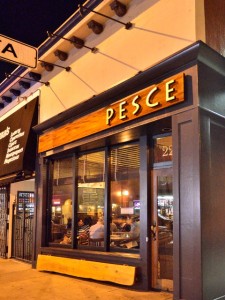Day Two of the 2012 Game Developers Conference was all about the physics for me. Today, there was an all day Physics for Game Programmers tutorial, and like with the previous day’s math tutorial, some of the talks were hits and some were misses. The day began with a great discussion of collision detection and a conceptually complex method utilizing something called a configuration space object. Details about the process of creating a utility object by sweeping one of the game objects with another. The properties of the object generated by this sweep, the configuration space object, allows for quick collision detection by determining if the coordinate system origin in configuration space lies within the CSO. Not only does this procedure allow for the detection of the collision, but it also allows for the rapid determination of the collision point, and the collision normal, both of which are critical for resolving the velocities after the collision. You can learn more about this procedure and download the code at http://www.dtecta.com/.
The second talk of the day was a party of tensors and Newton’s 2nd Law. I loved it! Solving Rigid Body Contacts by Richard Tonge of nVidia focused on collision resolution. Once you know that a collision has occurred, you then need to figure out how to handle that collision. One thing that I found interesting is that was that game devs use the term impulse to refer to a as opposed to the physical definition of
. After listening for a while, it was completely understandable why. Collision resolution happens instantaneously, and the change in the objects motion is achieved by applying the simple statement,
. Getting this
physically right, doesn’t always result in physical behaviour from the simulation. Tweaking of collision-induced impulse is needed to produce more realistic appearing motion and reactions.
The afternoon sessions were all about ragdoll physics, which would have been very interesting if there was any depth to the talks, but they were all very high-level and filled with pretty video sims and devoid of any serious discussion of the physics modeling. Unfortunate, that. The salvation of the afternoon was a talk by the tutorial’s facilitator and organizer, Jim Van Verth. Jim talked about the basics of fluid simulation including introductions to the Navier-Stokes equation and methods for modeling and solving it.
The most straightforward way to model fluids is by gridding your space and evaluating the continuity and momentum equations discretely at the center of each grid element. This is robust, but expensive. It also only operates in the space in which you’ve established your grid. You won’t want to use it world-wide because of the computational costs, but it is useful for very localized fluid effects such as puffs of smoke during destruction events and the like. This method also doesn’t model splashes well. The fluid remains intact, rather than separating into droplets as a real fluid will.
A method that is more globally applicable and that does a good job of modeling splashes is Smooth Particle Hydrodynamics (SPH). SPH uses kinetic modeling of small particles with an attractor force, simulating a surface tension, to loosely bind the particle together. The ensemble of particles is then skinned to produce a realistic looking fluid surface. Splashes are well modeled by this technique, and since its a kinetic system, not a cell-based system, its globally applicable. You don’t need to grid out your space, and the fluid is free to flow wherever physics takes it in the world.
The last method demonstrated was a method of simply modeling the surface of a fluid, such as an ocean surface. Ocean waves are not of a simple single frequency, but are complex structures comprised by a multitude of wave modes. To generate realistic looking waves, a Fourier sum is used to add multiple wave modes to the entire surface and the wave speed is properly calculated via a frequency-dependent dispersion relationship. Building these modes in frequency-space and then using a FFT to transform back to time-space results in extremely realistic fluid surfaces. This is the method used to generate the ocean surface in the movie Titanic. Cool!
 Last event of the day was the IGDA party. Its something that we attend every year, at least for a half-hour or so. Typically there have been munchies and various innovated board games scattered around. This year, there were vendor tables, no munchies, minimal board games, and a TON of people! Its probably a good thing the fire inspector didn’t stop by. They’d have shut the place down. Oh, yeah, and there were ribbon dancers. :S Just what kind of party is this? It wasn’t your typical professional organization party.
Last event of the day was the IGDA party. Its something that we attend every year, at least for a half-hour or so. Typically there have been munchies and various innovated board games scattered around. This year, there were vendor tables, no munchies, minimal board games, and a TON of people! Its probably a good thing the fire inspector didn’t stop by. They’d have shut the place down. Oh, yeah, and there were ribbon dancers. :S Just what kind of party is this? It wasn’t your typical professional organization party.
Wednesday, the main part of the conference begins and the expo hall opens! Yay swag! I’ll have pics of swag after my first swing through the expo hall. If you see something you like, be sure to leave a comment for me.


